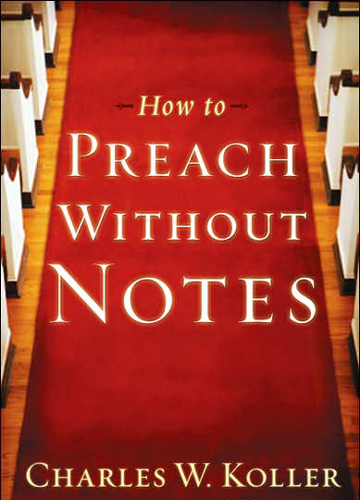|
|
||
How To Preach Without Notes
How To Preach Without Notes by Charles C Koller is a book that defines the mechanics of sermon preparation in order to help preachers prepare for the pulpit with a freedom to preach the word of God to the people of God. In How To Preach Without Notes, Charles W Koller makes several pertinent statements. “Preaching without notes does not mean preaching without preparation, as might be suggested by the familiar terms impromptu, extempore, extemporary and extemporaneous” (Koller 9). “Preaching without notes does not mean preparation without notes. Indeed, carefully constructed notes are the basis of freedom from notes in preaching” (Koller 10). “Preaching without notes does not mean that there should be no notes on the pulpit. As a matter of fact, the preacher is well advised to have these notes with him whenever he preaches; if at any time he should need them, he would need them badly” (Koller 10). “Preaching without notes does not mean to stand free from the pulpit and thus draw attention to the fact that the speaker is preaching without notes; such diverting of the attention from the message might be as costly as improper attire, or bad grammar or distracting mannerisms” (Koller 10). In other words, How To Preach Without Notes by Charles W Koller is a book that will help preachers carefully constructs notes so that they will have a freedom in the pulpit to preach God’s word to God’s people. Sermon Structural Components (Chapter 12)Charles W Koller asserts that a strong sermon is made up of strong parts. If the structure of the sermon is strong throughout, then the sermon should be effective in all parts. The introduction will introduce. The illustrations will illustrate. The conclusion will conclude and the message will be a message indeed. Charles W Koller notes several structural components of the sermon. The title or topic of the sermon must be brief and attractive. It must be indicative of the content of the sermon and it must relate to the needs and interests of the hearers. Spending time to phrase the sermon’s title or topic will pay great dividends to both the preacher and the hearers. The main points should flow from the topic or title of the sermon and they should expand or explain the topic or title of the sermon. Charles W Koller gives an example of this. The title of the message is: The World’s Most Attractive Church. The main points are: They were a united membership, they were an informed membership, they were a spiritual membership and they were a witnessing membership (Koller 96, 97). As you can see, the main points were complete statements, mutually exclusive and parallel in form. Koller also stated that there must be progression, discernible to the audience, and this should lead cumulatively to a strong finish (Koller 79). The sub points should follow the structure of the main points. They should be complete statements, mutually exclusive and parallel in form. Also the sub points should progress in sequential form. The illustrations should illustrate. They need to be conducive to the purpose of the sermon and they should be true and plausible. Koller makes it very clear when he states that no matter how good the illustration, unless it contributes to the momentum, clarity and force of the sermon, it must be left out. The introduction is not the sermon. The introduction should introduce the sermon’s topic or title. It should be clear and precise. It should provide the audience with the relevance of the topic or title. The conclusion should reflect the topic or main point or both. The conclusion should bring the sermon to a burning focus. The conclusion should appeal to the audience for a response, either an action or a resolve. There is so much more to learn from Charles W Koller. If you want to learn how to create powerful sermons, then you need to read How To Preach Without Notes. Check it out - How To Preach Without Notes. Some Quotes From Charles W Koller: "Preaching without notes is largely a matter of structure." "An outline that stands out clear and sharp is the first long step to freedom in the pulpit." "A sound structure is helpful not only to the preacher, giving him a sense of timing, progress and proportion, but to his audience as well." "The kind of outline that is structurally adapted to memorization, retention, and recall is not achieved without labor, but is worth all that it costs." "Excellence of structure can not compensate for the absence of the Holy Spirit. Without the guidance and empowerment of the Holy Spirit, the preacher, however skillful in homiletical techniques, would be only 'a homiletical carpenter' producing and delivering 'wooden' sermons." "Structural soundness can not supply that life of holiness which is basic to pulpit power. There is an eloquence of the lips, and there is an eloquence of the heart." "A flawlessly prepared sermon reemains lifeless and powerless until the preacher throws himself heart and soul into the message." Related Resources and Tips |
SEARCH THIS SITE |
|
|
|
||
|
Return to top
Homepage | Free Topical Sermons | Free Expository Sermons | Free Evangelistic Sermons | Free Christmas Sermons Free Easter Sermons | Free Mothers Day Sermons | Free Short Sermons | Free Sermonettes | Free Wedding Messages Free Sermons For Young People | Free Sermons For Youth | Free Sermons For Children | Free Online Sermons Free Sermon Outlines | Free Sermon Illustrations | Sermons Sermons Sermons | How To Write A Sermon | How To Write A Sermon Outline Writing A Funeral Sermon | Web Builders For Churches | Web Hosting For Churches | Web Design For Churches | Web Pages For Churches Web Keywords For Churches | Google Adsense For Churches | Site Map Disclaimer/Disclosure | Sermon Information |
||
|
© Copyright 2008 -
All Rights Reserved No reproduction permitted without permission www.more-free-online-sermons.com How To Preach Without Notes by Charles W Koller | ||




